Forts of Salvador da Bahia
Iconic Historic Sites
Forte de Nossa Senhora de Monte Serrat
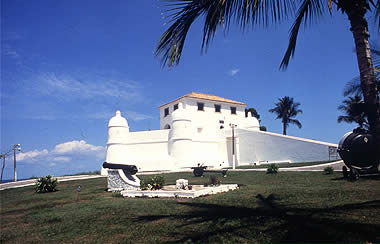
This fort belongs to the Army and is considered the most beautiful military construction from the Brazilian colonial period. Its construction started in 1583, on a strategic positioning area on the highest spot of the peninsula, facing the port.
Concluded in 1742, without changing its original plan, remains until today with a house of command and nine cannons. Its history brings back to us the historical moments of the heroic resistance to the Dutch in 1624 and in 1638.
Since 1993, it has sheltered the Armaria Museum, which contains civil and military armament. From this fort visitors have a beautiful view of Todos os Santos Bay entrance, from where you can see Salvador in one side and Itaparica Island on the other side.
Forte de Santa Maria
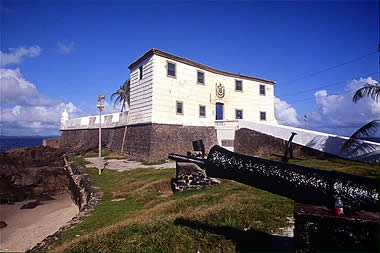
This fortress, which belongs to Brazilian Navy, was raised after the Dutch invasion, in 1624, when the Portuguese governors built two fortresses in the small cove of Porto da Barra in order to cross fire and avoid new landings.
This fortress was concluded in the XVIII century and has kept an image of Our Lady for many years. Its heptagonal Italian-type shape has not been modified along the years.
Forte de Santo Antônio Além do Carmo
It was constructed in the second half of the XVII century to resist to the Dutch during the invasion of 1638. It used to be a prison for important people of the national political life from the XVIII century.
The fort has suffered many changes since the XIX century. Although it has never participated on a war, it has always occupied a strategic place in defense.
Forte de Santo Antônio da Barra
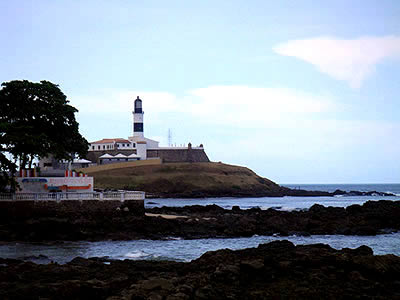
This fort, which belongs to Brazilian Navy, is located in the north entrance of Todos os Santos Bay. The construction was initiated in 1536, and had, originally, the shape of a tower with ten sides.
Enlarged and repaired between 1583 and 1587, it suffered changes between 1602 and 1702. It is considered the first fortress raised in Brazil and shelters the Nautical Museum, which contains maps, navigation equipments, and maquettes of old Portuguese and Spanish ships and findings of the ship Galeão Sacramento, which has sunk in the entrance of Todos os Santos Bay.
Forte de São Diogo
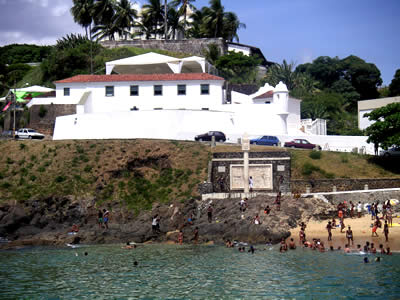
It was constructed in the middle of a hill called Morro de Santo Antônio, at the right side of Porto da Barra beach, in the end of the XVI century. The construction was enlarged and transformed into a fort in order to avoid the invasions through the only existing safety port in the entrance of Todos os Santos Bay.
This port used to be a target to the ones who intended to attack the city by the South. It was concluded in 1722, and on the top of the entrance there is the emblem of Imperial Brazil.
It was built with an irregular Italian-type plan, and has two floors. It suffered several changes in its original shape along the years. Besides being a historical attraction, this fort is an important center of leisure for both inhabitants and visitors.
Forte de São Pedro
It was constructed in a place chosen by the Dutch in 1624 for building a fortress, between 1646 and 1723. It used to occupy a strategic place in the defense city’s southwestern limits and its main goal was to avoid the invaders’ access from Porto da Barra to Salvador.
It was conceived in a square shape, which represented a progress for that time. In this fort, the Brazilian military offered resistance to Portuguese colonial government, for the first time, in 1822, which resulted in the beginning of the war for Brazilian Independence.
Forte do Barbalho
Formerly known as Fort N. S. do Monte Carmelo or Monte do Carmo , this construction is located at the far northern side of the city, an area it was designed to protect along with Fort Santo Antonio do Além Carmo. Its construction dates back to 1638, when Luiz Barbalho Bezerra orders the construction of new trenches in this area against new Dutch invasion attempts. Throughout the centuries the fort housed the public jail and the S.Lázaro Lazaretto infirmaries. Shaped as a quadrangular polygon, the fort is built in stonemasonry and has a circular turret and three fortifications at the sides guarded by watch posts. This design was initially influenced by the Italians and later by the French fortifications. Its original conception had quarters only in the plain area and a guard corps superposed by the commander’s quarters. The tribune-shaped gates are most likely a consequence of the changes it underwent in the 19th century.
Forte Santo Alberto
This fort belongs to the Army and is located on Jequitaia Avenue, in the Lower City.
It is known as Forte da Lagartixa (Lizard’s Fort), because one of its cannons – on which there was a picture of a lizard – shot in July 2nd, 1822 for announcing that Portuguese troops were leaving the place, and that Bahia had got its Independence. Its construction was initiated in the second half of the XVI century, around the old São Tiago Tower. Archeological findings of the tower were recently discovered and can be seen by visitors.
Concluded in 1610, Fort Santo Alberto , as well as Fort Santo Antônio Além do Carmo , used to integrate a system of defense for protecting against attacks from the land, in the north side of the city. Dutch soldiers occupied the fort during the invasions of 1624 and 1638.
Forte São Marcelo
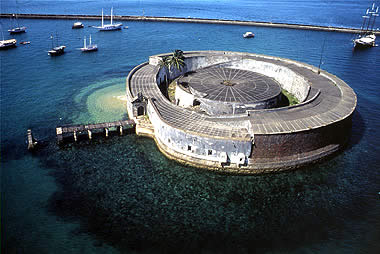
Under IPHAN’s protection, this fort was built with stones, in triangular shape, in the beginning of the XVII century, on the reefs in Salvador’s port entrance. Reconstructed with stones, after the Dutch invasion, in 1624, it got a circular shape and the mission of protecting the city from the foreign attacks. It is accessed by boat from the Rampa dos Saveiros, beside Modelo Market.
